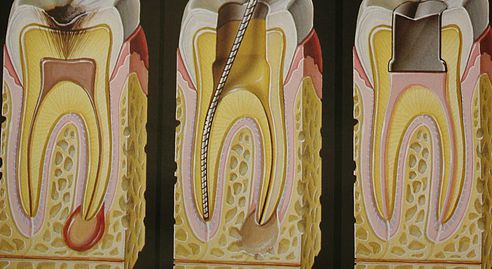Our teeth are meant to last a lifetime. Sometimes, however, damage occurs to a tooth (often from a deep cavity or an injury that causes a tooth to crack) and the inside of the tooth becomes infected. This infection damages the pulp of the tooth - the network of blood vessels and nerves inside.

What is a Root Canal?
Root Canal In Upper East Side is a treatment used to repair and save a tooth that is badly decayed or becomes infected. During a root canal procedure, the nerve and pulp are removed and the inside of the tooth is cleaned and sealed. Without treatment, the tissue surrounding the tooth will become infected and abscesses may form."Root canal" is the term used to describe the natural cavity within the center of the tooth. The pulp or pulp chamber is the soft area within the root canal. The tooth's nerve lies within the root canal.A tooth's nerve is not vitally important to a tooth's health and function after the tooth has emerged through the gums. Its only function is sensory -- to provide the sensation of hot or cold. The presence or absence of a nerve will not affect the day-to-day functioning of the tooth.
Why Does Tooth Pulp Need to Be Removed?
When a tooth's nerve tissue or pulp is damaged, it breaks down and bacteria begin to multiply within the pulp chamber. The bacteria and other decayed debris can cause an infection or abscessed tooth. An abscess is a pus-filled pocket that forms at the end of the roots of the tooth. An abscess occurs when the infection spreads all the way past the ends of the roots of the tooth. In addition to an abscess, an infection in the root canal of a tooth can cause:Continue reading below...Swelling that may spread to other areas of the face, neck, or headBone loss around the tip of the rootDrainage problems extending outward from the root. A hole can occur through the side of the tooth with drainage into the gums or through the cheek with drainage into the skin.
What Damages a Tooth's Nerve and Pulp in the First Place?
A tooth's nerve and pulp can become irritated, inflamed, and infected due to deep decay, , and/or large fillings, a crack or chip in the tooth, or trauma to the face.
What Are the Signs That a Root Canal Is Needed?
Sometimes no symptoms are present; however, signs you may need a root canal include:
- Severe toothache pain upon chewing or application of pressure
- Prolonged sensitivity/pain to heat or cold temperatures (after the hot or cold has been removed)
- Discoloration (a darkening) of the tooth
- Swelling and tenderness in the nearby gums
· A persistent or recurring pimple on the gums